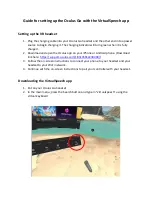
J&M BT-04 Series Helmet Headset Installation Instructions
WARNING!
Helmet speakers may not be legal in all jurisdictions. Check your local laws BEFORE using this product. J & M Corporation cannot control the circumstances surrounding the sale of this equipment, the
quality of installation, or the specific helmet into which this equipment is installed. Accordingly, J & M Corporation makes no warranties, expressed or implied, related thereto. A helmet with this equipment installed
may not protect the user from injury. The user assumes all liability in conjunction with accidents, injuries or losses of any kind arising out of the use of this product. Additionally, this product should not be used in
any way that would impair the user’s ability to hear traffic or other noises. Accordingly, the volume should be kept low or off, depending upon the circumstances.
5B. Installation Instructions For Most
Full-Face Style Helmets
BT-04
1
Figure
BT-04
BT-04
4
Figure
IMPORTANT NOTE: Modern day helmets can
present special challenges for wireless headset
installation. If you do not feel you are up to the
task, you may send your “un-modified” helmet to
our factory in Tucson and we will perform the
installation for a nominal fee. (Please call first to
ensure that we are able to install a headset into
your particular brand/model of helmet.)
Installation into Full-Coverage Style
Helmet
1. Most full coverage-style helmets have cheek
pads or a complete nose section that can be
removed. Carefully do so at this time, paying
special attention so as not to break or damage
any of the polystyrene parts.
2. Using a headset speaker as a guide, mark
the circular pieces of styrene to be removed
from the back of the ear area of the nose sec-
tion or the cheek pad.
See Figure 1.
With an
Exacto® knife, cut a hole slightly smaller than
the speaker so that the speaker will “press fit”
into the hole without damaging the styrene.
An airtight seal is necessary to preserve bass
response as the sound pressure from the back
of the speaker housing should not be allowed
to mix with the sound pressure from the front.
Also, be careful not to cut or damage the fabric
lining
3. Locate an area in the nose section just to the
left of the center to mount the microphone.
See Figures 3 & 4.
Make sure that this
placement will not interfere with any venting
mechanisms or other parts of the helmet upon
re-installation of the nose section.
2
Figure
3
Figure




























